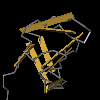?
 
First Src homology 3 domain of Tyrosine kinase substrate (Tks) proteins Tks proteins are Src substrates and scaffolding proteins that play important roles in the formation of podosomes and invadopodia, the dynamic actin-rich structures that are related to cell migration and cancer cell invasion. Vertebrates contain two Tks proteins, Tks4 (Tyr kinase substrate with four SH3 domains) and Tks5 (Tyr kinase substrate with five SH3 domains), which display partially overlapping but non-redundant functions. Both associate with the ADAMs family of transmembrane metalloproteases, which function as sheddases and mediators of cell and matrix interactions. Tks5 interacts with N-WASP and Nck, while Tks4 is essential for the localization of MT1-MMP (membrane-type 1 matrix metalloproteinase) to invadopodia. Tks proteins contain an N-terminal Phox homology (PX) domain and four or five SH3 domains. This model characterizes the first SH3 domain of Tks proteins. SH3 domains are protein interaction domains that bind to proline-rich ligands with moderate affinity and selectivity, preferentially to PxxP motifs. They play versatile and diverse roles in the cell including the regulation of enzymes, changing the subcellular localization of signaling pathway components, and mediating the formation of multiprotein complex assemblies. |
